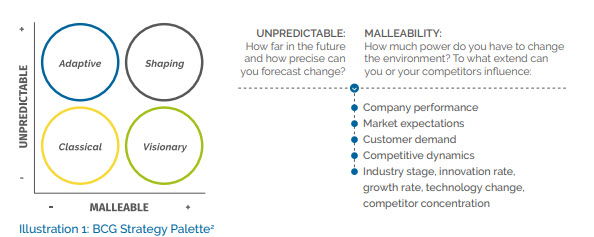Challenges for leaders in strategy design
Introduction
In our first article ‘Realizing your strategy successfully in a disruptive world’ we described three characteristics successful organizations have in common to effectively deliver strategies they have designed. Connecting strategy design with delivery, organization culture and leadership need to be aligned. In this blog we will highlight the BCG Strategy Palette and connect it to Leadership and Organization Culture.
Determining the right strategy approach
Strategy design follows in many cases the traditional way: analyze your situation, define your goals, draw up a step-by-step approach in business strategy and manage execution strictly. However, each business is different. An oil company, when compared to a software company, works in a different environment with different challenges. Long-term plans versus a more opportunistic and agile approach to strategy. How do you determine which is the most effective approach in which situation?
It becomes even more challenging for large organizations that operate in multiple business environments, diverse geographies, with different product categories and with a wide range of enabling functions. This diversity requires organizations to apply at the same time multiple approaches towards strategies for different parts of the organization. Within these multiple approaches, we nevertheless have seen that the connection between strategy, culture and leadership stays unchanged.
In a disruptive world, the diversity and range of business environments have increased. One strategy approach does not fit all. It is more important than ever to choose the right approach to strategy for the right business situation.
Herein lies the challenge for leaders: they need to know how to identify the most effective approach to business strategy, marshal the right thinking and behaviors, execute their plans, and be supported by the appropriate frameworks and tools.
The BCG Strategy Palette1 is a framework that allows leaders to match the strategy approach with different business environments. This Strategy Palette provides four archetypal approaches to strategy, tailored to the specific environment of each part of a business.
The Strategy Palette is composed on two dimensions: how predictable is the environment in which the company operates and how much power should a company have to change that environment. The four approaches are shown in illustration 1.

Four different approaches to strategy:

The four above mentioned approaches need to be handled with care, because the environment of an organization, and with that the predictability and the malleability, can change over time. On top of this, in an organization you can even be confronted with different environments per market, sales line or geography.
Companies working in markets with long planning horizons, like Oil and Cosmetics, are active in relatively stable contexts. A classical approach with clearly defined phases will prevail. Adaptive approaches will stimulate continual experimentation and grow opportunities that are successful. Companies that create entirely new products like electronics facilitate imaging but are relentless in their execution to realize their bold dreams. Companies like AirBnB and Uber focus beyond the borders of their company and orchestrate ecosystems and platforms of internal and external parties to dominate an environment.
In the table below we show different aspects of each of the four strategy types.

Each strategy approach needs its own Culture and Leadership
The four strategies, as stated in the Strategy Palette, offer a unique support to help secure the direction of the organization in alignment with its environment. Yet, we know a successful strategy does not only consist of creating the strategy of an organization, but that a combination with the correct execution will lead to a strategy’s success. Bearing this in mind, we have
formulated the culture and leadership that goes with each of the four strategies.
In the subsequent chapters, it will be explained which organizational culture best supports each of the strategies. When we talk about culture of an organization in this paper, we are referring to the ‘collective programming of the mind’ of a group of people. Culture, in this case, is referring to the fundamental assumptions of what it is to be a person and how individuals should interact within their own group and with outsiders.
Besides looking at the necessary organizational culture, strategy and leadership will also be connected and aligned. Having based our findings on interviews and the existing literature, we have tried to come up with a suitable leadership style for each strategy. In this paper, Leadership is defined as followed: “Leadership is the art of motivating a group of people to act
towards achieving a common goal”. The leader is the person in the group that possesses the combination of personality and leadership skills that makes others want to follow his or her direction.
An organization’s success can only be achieved by connecting Strategy, Organizational culture and Leadership. The power of linking these three elements, understanding them clearly and accepting that ‘leaders get the culture they model’, is key when bringing a strategy to life. The Peter Drucker quote ‘Culture eats strategy for breakfast’ reflects the reality clearly.
It is extremely important for Leaders to take great care to develop and model the right behaviors for others to see and imitate. Eventually, managers, leaders, and employees will model these behaviors themselves, which will help to create the culture in which people can bring the strategy to reality.

